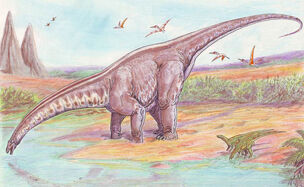
Restoration of Apatosaurus, a well known sauropod
Sauropodomorpha is a clade of saurischian dinosaurs that includes sauropods and their ancestral relatives. They existed from the Late Triassic Period to the end of the Cretaceous Period.
Description[]
Sauropodomorphs were primarily if not entirely herbivorous, and could browse higher than any other animal in their environment. This was due to their long neck, usually counterbalanced by a long tail. They had proportionally small skulls which had large nostrils and contained a battery of teeth.
Although early sauropodomorphs measured 2 meters or less in length,[1] after the end of the Triassic they became the largest land animals on the planet for their entire existence. Their immense size meant that most sauropodomorphs were quadrupeds.
Classification[]

Two Plateosaurus, basal sauropodomorphs (better known as "prosauropods")
Sauropodomorpha is one of the two major clades within the group Saurischia, the other being Theropoda. Traditionally, it is divided into two groups: Prosauropoda (containing "prosauropods" such as Plateosaurus) and Sauropoda (containing true sauropods such as Apatosaurus and Diplodocus). However, recent research suggests that there is no true difference between these two groups.[2]
The following is a simplified cladogram of Sauropodomorpha based on a 2011 paper.[3] Sauropoda is contained within Massospondylidae.
| Sauropodomorpha |
| ||||||||||||||||||||||||||||||||||||||||||||||||||||||||||||||||||||||||
Time range[]
Sauropodmorphs were some of the dominant terrestrial herbivores from their evolution in the Late Triassic to the Cretaceous-Paleogene extinction event when all non-avian dinosaurs became extinct.[4]
References[]
- ↑ Langer, M.C., Abdala, F., Richter, M., and Benton, M. (1999). "A sauropodomorph dinosaur from the Upper Triassic (Carnian) of southern Brazil." Comptes Rendus de l'Académie des Sciences, 329: 511-;517.
- ↑ Fernando E. Novas, Martin D. Ezcurra, Sankar Chatterjee and T. S. Kutty (2011). "New dinosaur species from the Upper Triassic Upper Maleri and Lower Dharmaram formations of central India". Earth and Environmental Science Transactions of the Royal Society of Edinburgh 101 (3-4): 333–349. doi:10.1017/S1755691011020093.
- ↑ Cecilia Apaldetti, Ricardo N. Martinez, Oscar A. Alcober and Diego Pol (2011). "A New Basal Sauropodomorph (Dinosauria: Saurischia) from Quebrada del Barro Formation (Marayes-El Carrizal Basin), Northwestern Argentina". In Claessens, Leon. PLoS ONE 6 (11): e26964. doi:10.1371/journal.pone.0026964. PMC 3212523. PMID 22096511.
- ↑ Gradstein, F.M., Ogg, J.G. and Smith, A.G. (2004). A Geologic Time Scale 2004, Cambridge University Press.